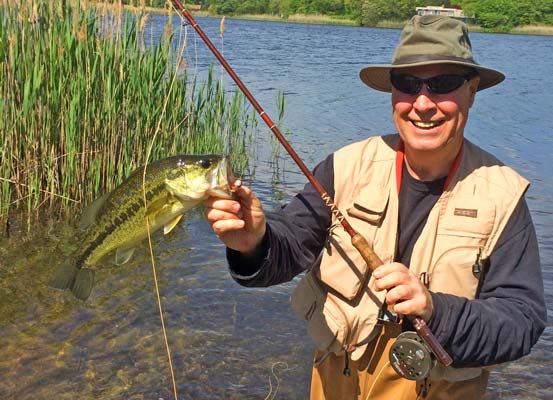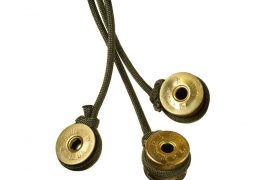
Pictured above: The author shows off a chunky early fall bigmouth that smacked a cork popper on an eastern Long Island pond.
Surface bugs tempt big bass when the leaves change color.
The small bass bug left barely a ripple on the surface as I gave it a light twitch, a slight pause and then another twitch. Filled with anticipation, I tried to outwait what I hoped would be a lunker bigmouth sizing up my offering. Slowly I counted, “three alligators, four alligators, five,” and twitched the bug again. Instantly, the surface erupted as a bass inhaled the imitation and rolled toward open water. I delayed my strike just long enough to let the husky fish turn and then set the hook with a sharp tug of the fly line. The battle that ensued included a head-shaking jump followed by a cartwheel. It was fall bass fishing at its finest and I was thrilled to be using a fly rod.
The simple mention of fly-fishing can be a conversation stopper in some serious bass fishing circles. For many who target largemouths with powerful conventional rods, 30-pound-test braided line, a tournament mentality and baitcasting reels favored for their ability to winch hawgs out of the nasties, the thought of gently presenting a neatly dressed deer-hair frog or rubber-legged cork popper can seem a little too refined. Turns out, however, that today’s fly gear has muscle enough to accomplish the task with ease. In some situations, such as fishing in the gin-clear waters of mid-October, it might even have an edge on more traditional bassin’ techniques.

Although it is true that fly-rod bass fishing calls for gentle presentations at times, it’s a far cry from dapping trout on tiny creeks you jump across or targeting stockies in the local mill pond. It’s also a lot easier to get started than you might think. You’ll only need a few basic patterns and simple gear to get in on the fun. Consider also that most bass fans already have a pretty good sense of where to find their quarry and you may already be halfway to besting your first bigmouth with feathers and fur. Once you do, you’ll be hooked forever on the early fall season because the bucketmouths are refreshed by dropping water temperatures, competition from other anglers is light, and most of the action takes place on the surface.
It’s no secret that largemouth bass will take a frog, mice and various cork popper patterns throughout the summer months. The problem is that warm water means beating the brush, fishing in tight quarters, and tempting blowdowns, heavy structure and thick weed mats with every cast.
Come the fall, however, retreating weeds create more open pockets, predators push out from the shore and, for a brief period in late September and early October, anything on the surface becomes fair game for bucketmouths of all sizes. That can lead to some awesome days like the one I had in the third week of October two years ago. Working cork poppers on that midday trip, I caught and released more than 30 bigmouths ranging from 8 to 19 inches in the span of just three hours. Last year, during the first week of October, I used a deer-hair frog to drill over a dozen bass up to 4 pounds and then tied on a small…





